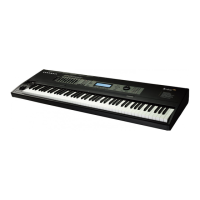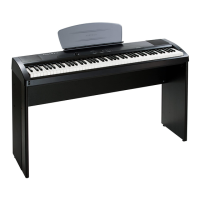2-6
Triple Modular Processing
Editing Triples
The parameters on the ALG page consist of the algorithm itself, and the DSP blocks within the
algorithm (In the diagram, the second DSP block in the algorithm is selected). Use the cursor
buttons to select the parameters, and a data entry method to change the value of the selected
parameter.
Amplitude Envelopes
A layer’s amplitude envelope is a critical element of the layer’s sound; it determines the layer’s
attack, decay, and release times—among other things. These features are controlled in one of
two ways: by default settings stored in a layer’s keymap, or by the settings for the parameters
on the layer’s AMPENV page.
The amplitude envelope gets applied to a layer’s audio signal as it passes through the
algorithm’s AMP block (if it contains one). All the normal VAST algorithms (1–31) end with an
AMP block, so normal VAST layers always use an amplitude envelope. This isn’t true for all
triple algorithms, however.
All the Layer-3 algorithms (101–126) end with AMP blocks, which ensures that there’s at least
one amplitude envelope for every triple. For Layers 1 and 2 of a triple, the AMP block is
optional. To include an AMP block in an algorithm, assign a value of AMP in any one-stage DSP
block from F1 to F4 (the PITCH block, if the layer contains one, has a fixed value).
It’s important to keep in mind that whatever happens in the amplitude envelops in Layers 1
and 2 of a triple, the amplitude envelope in layer 3 affects the sound of the entire triple. For
example, if you have a long release in the amplitude envelope in Layer 1, but a short release in
the amplitude envelope in Layer 3, Layer 1’s release will continue only as long as Layer 3’s
release
AMP Blocks in Layers 1 and 2 of a Triple
When you put an AMP block in Layer 1 or 2 of a triple, that layer uses its own amplitude
envelope, as specified on the layer’s AMPENV page. This envelope affects only its own layer,
and not the subsequent layers in the triple. Also, amplitude envelopes (if any) applied to
Layers 1 and 2 don’t apply MIDI volume data; only the amplitude envelope in Layer 3 controls
overall volume.
A layer that doesn’t contain an AMP block ignores its own amplitude envelope. So, for example,
if Layer 1 of a triple has no AMP block, Layer 1’s output has no amplitude envelope. As the
signal from Layer 1 mixes with the signal from Layer 2, the amplitude envelope from Layer 2, if
any, may affect the sound from Layer 1 (this depends on Layer 2’s inputs—see Input Locations on
page 2-7.
When to Use AMP Blocks in Layers 1 and 2
Put an AMP block in Layer 1 or Layer 2 whenever you want that layer to use its own amplitude
envelope. This affects the layer’s sound to varying degrees, depending on two things: the
keymap assigned to the layer, and the mode (Natural or User) of the layer’s AMPENV.
AMP blocks can be particularly important in Layers 1 and 2 when those layers use keymaps that
contain ROM samples or edited versions of ROM samples (especially samples of acoustic
sounds like piano or strings). That’s because the factory-default (natural) amplitude envelopes
of many of these keymaps also control the decompression of the keymap’s samples (to
maximize audio quality, many samples are stored in compressed form, and are decompressed
just before playback). If there’s no AMP block, there’s no amplitude envelope, and therefore no
decompression information. This can alter the sound of a ROM sample drastically.

